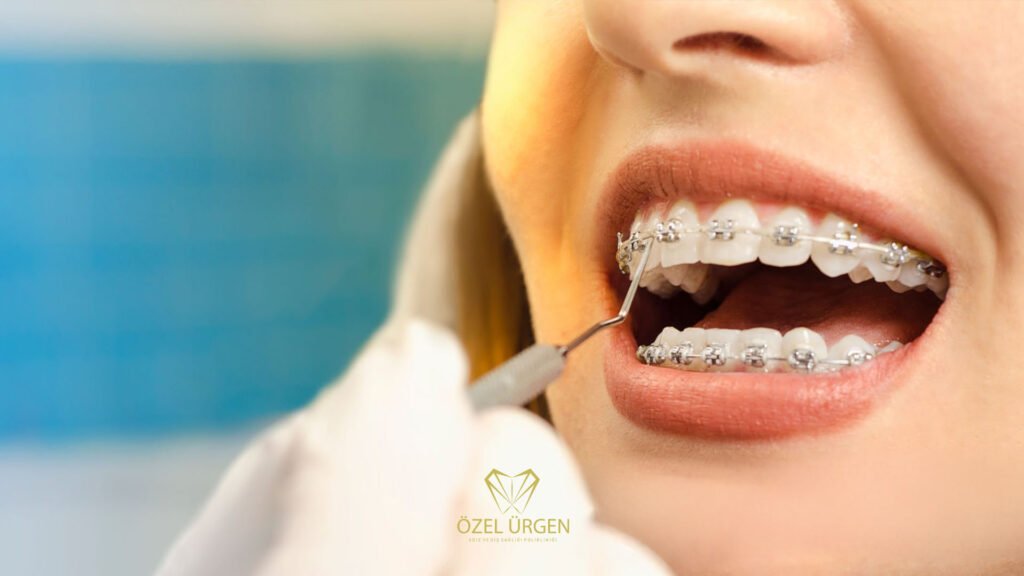- Mon - Fri 10:00 - 19:00
- Hacıhalil, Hükümet Cd. No : 80 Gebze/Kocaeli
- info@urgendis.com

Smiling is one of the most powerful and universal forms of communication. It not only expresses our emotions but also reflects our confidence in ourselves and toward others. However, not everyone’s smile is naturally perfect. Misaligned teeth, jaw discrepancies, or crowding can make you feel uncomfortable while smiling and may even affect your oral health over time.
This is where orthodontics comes in. Orthodontics is a specialized branch of dentistry aimed not only at aesthetics but also at maintaining and improving oral and jaw health. Properly aligned teeth and jaws facilitate chewing, make cleaning between teeth easier, and reduce the risk of gum problems. Well-aligned teeth also positively contribute to speech and breathing functions.
Modern orthodontic treatments are no longer limited to traditional braces. With solutions such as clear aligners, functional appliances, and aesthetic bracket systems, it is possible to prioritize both appearance and comfort. In short, orthodontics not only enhances your smile but also ensures a healthy oral structure.
Orthodontics primarily aims to align teeth correctly and optimize jaw harmony. A properly aligned dentition not only creates an aesthetically pleasing smile but also facilitates chewing, improves speech, and supports gum and jaw health.
Orthodontic treatments that begin during childhood or adolescence are especially important for guiding the development of teeth and jaws. However, effective and aesthetic results can also be achieved in adults using modern methods, allowing people of all ages to enjoy a healthy and confident smile.

Orthodontic treatment is important not just for improving your smile but also for maintaining oral and jaw health. Problems such as crooked or misaligned teeth, excessive spacing or crowding, and upper and lower jaw mismatches (overbite or underbite) can lead not only to aesthetic concerns but also to difficulties in chewing, speech problems, gum disease, and jaw joint pain over time.
Therefore, orthodontics is suitable for both children and adults, offering various advantages for each age group. Early treatments are particularly beneficial for guiding jaw and teeth development, while adults can also achieve effective and comfortable results through modern orthodontic methods.
Orthodontic treatment is tailored to each individual through personalized planning. It not only ensures a healthy oral structure but also provides an aesthetically pleasing smile and boosts self-confidence. Every patient’s needs are unique, so the treatment process is carefully planned and monitored to achieve long-lasting functional and aesthetic results.
Orthodontic techniques vary in terms of appearance and comfort. Today, there are many options that allow patients to undergo treatment without compromising their quality of life.
The traditional and most widely used method. Metal braces use brackets and wires attached to the teeth to gradually move them into the correct position. Modern wires are much thinner and more aesthetic, and treatment duration has been reduced.
Ceramic braces are an alternative to metal braces and are tooth-colored, making them less visible. They are often preferred by patients with aesthetic concerns.
Clear aligners have revolutionized the field in recent years. Nearly invisible, these removable aligners make eating and oral hygiene easier while providing a comfortable treatment experience.

Lingual braces are placed on the inner surfaces of the teeth, making them completely invisible. They are an ideal option for adult patients with high aesthetic concerns.
In some cases, simply aligning the teeth is not enough. For narrow jaws or jaw discrepancies, jaw expansion or functional appliance treatments are applied. These methods are particularly effective in children and adolescents.
Orthodontic treatments do more than create an aesthetically pleasing smile; they also significantly support oral and dental health. Properly aligned teeth make brushing and flossing easier, preventing plaque and tartar buildup and protecting gum health. Chewing and speech problems are resolved, and proper alignment of the upper and lower jaws reduces excessive stress on the jaw joint.
All of this enhances functional comfort and boosts self-confidence in social and professional settings. In short, orthodontics is an investment that offers a healthy oral structure and an attractive smile, improving overall quality of life.
The orthodontic treatment process varies depending on the individual and the chosen method. Generally, the steps are as follows:
The duration of treatment generally ranges from 12 to 36 months, depending on the teeth and jaw structure. However, modern techniques and digital planning can shorten the treatment time.

Experts recommend that children have their first orthodontic examination around 7–8 years old. At this age, potential jaw and dental problems can be diagnosed early, and treatment can take advantage of the growth period for more effective results.
Adults may also undergo orthodontic treatment for aesthetic concerns or functional problems. With modern methods, there is no age limit; proper planning allows successful results at any age.